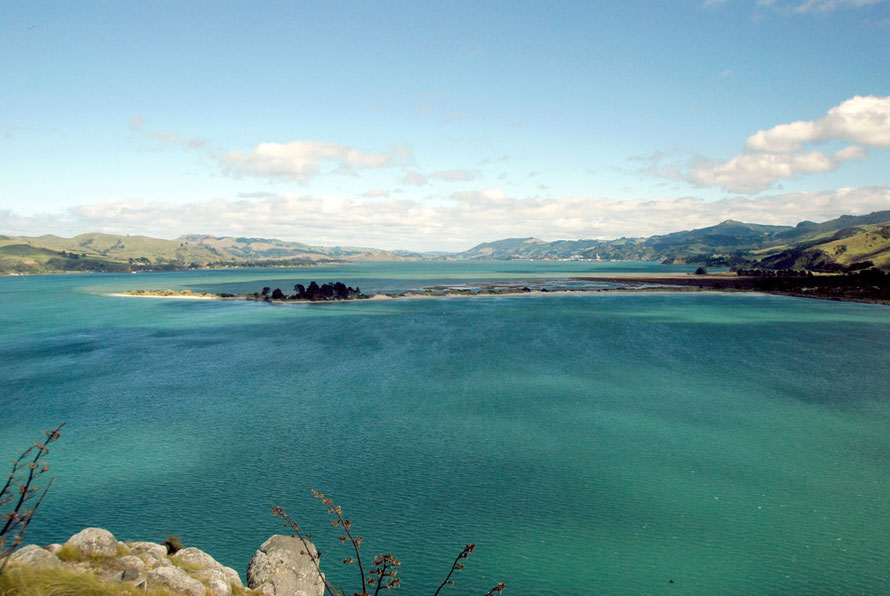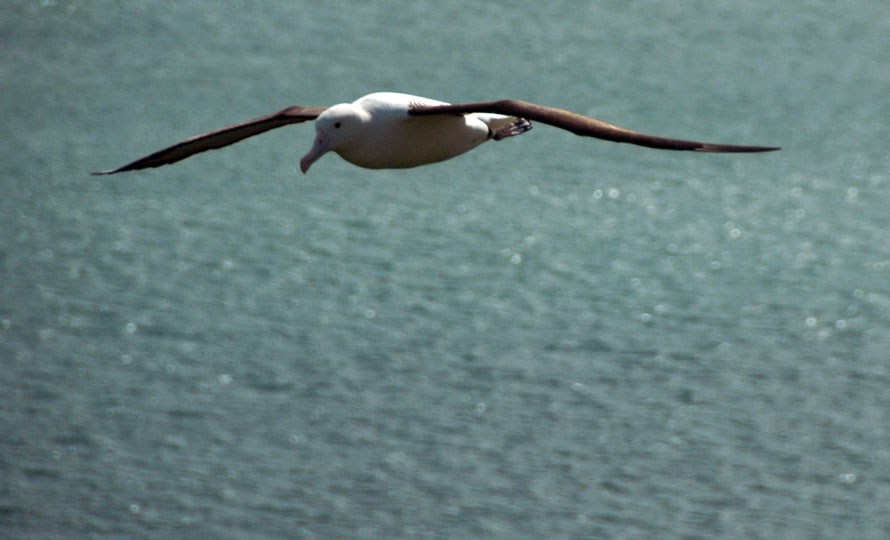II. The Toroa or Northern Royal Albatross

There are 21 species of albatross. Of the four genus the Diomedea are the largest and after the Wandering Albatross the Royals are the next biggest sea bird in the world.
Mollymawks (Thalassarche) are another genus, which we saw when crossing the Foveaux Strait to Stewart Island
The largest albatross wingspan is some 3.4m (11.2ft). Albatross are incredibly efficient soaring machines. They use headwinds and updraughts from waves to glide effortlessly with their wings locked into position by a shoulder-lock that keeps the wing when fully extended without any muscle expenditure or increase in heart rate.
This flying efficiency is absolutely dependent on the wind and waves. Becalmed albatross have to sit out still weather on the surface of the sea. But their efficiency allows them to use the weather systems of the southern oceans and North Pacific to fly vast distances in search of patchily available food sources.

Albatross mate for life and have evolved elaborate recognition displays that ensure they have really reunited with their mate for biennial chick rearing.
They are also philopatric, meaning that they usually return to their natal colony to breed - in some species the maximum distance a bird will breed from its original hatching site is just 22m (72ft).
There are two species of Royal Albatross - the Northern and Southern. The Northern has the latin name Diomedea sanfordi. It is called toroa by mainland Maori and hopo by the Moriori of the Chatham Islands.
Why is it called 'Royal' you might ask? This is probably due to New Zealand's huge and abiding loyalty to the British Crown.
The 'sanfordi' in the Latin name is linked to Leonard Cutler Sanford (1868-1950) who was a hugely influential amateur American ornothologist who sat on the board of trustees of the American Museum of Natural History. He was responsible for building up its massive bird collection (including the purchase of the 280,000 specimens in Lord Rothschild’s private museum at Tring in England).

Sanford is also commemorated in the names of Sanford's Sea-eagle (Haliaeetus sanfordi), Sanford's Bowerbird (Archboldia sanfordi), and Sanford's Brown Lemur (Eulemur sanfordi).
The Northern Royal was named such in 1917 by Robert Cushman Murphy who described it from a specimen from the Chatham Islands. Murphy was at the time the Lamont Curator of birds at the American Museum of Natural History.
Lancelot Eric Richdale, OBE was a teacher and ornithologist and the driving force to gain protection for the colony of Northern Royal Albatrosses at Taiaroa Head, Otago, after discovering the first successful fledgling there in 1938.

Kyle, our tousle-headed, blue-eyed, deer-hollering, big-surf-wave charging host at the bach had said a windy day was best for seeing the albatross and no one could deny it was windy. After all, it had blown his boat off its mooring the night before and it was blowing a hoolie on the headland.
Looking over the compound fence on the Taiaroa headland we caught glimpses of a big white wing looping up from behind the brow of the headland. But nothing more. We determined to enter the Reserve for quite a lot of money (NZ$90 - £45).
The talk about the albatross was pretty interesting. The colony of Northern Royals has only been established since the late 1930s although the first egg had been seen back in 1919. Since then the site has been assiduously guarded with fences and ground-predator traps and on-site veterinary care.
25 pairs of Northern Royals now breed at the site (1% of the global population). We were told that today we would see adolescent birds of between 4-8 years old that had returned to the headland to look for mates to team up with for life.
They were there just kind of grooving around and trying out things like landing on land - having been at sea without a break since they had left the colony as newly-fledged yearling birds. We were also promised a view of the few chicks still to fledge.

The presentation outlined some of the unique features of the albatross. They have a three jointed wing and can lock the joints in their wings to enable them to glide for hour and after hour. They also use the third joint to double-fold their wings when floating on the surface of the sea or when on land.
This double folding gives them the rather truncated aspect they have when on land, almost as if they had tucked their dress into their knickers, so to speak.
There was a skeleton of a Northern Royal in the lecture room. I was amazed at the slenderness of the bird's bones and particularly its wing-bones which seemed no thicker than twigs.
The albatross has a big head which is largely accounted for by the size of the beak. The top half has a sharp hook. This big and powerful beak is used to chop up squid and octopus with a scissor action while their big powerful feet give them stability in the water.
The inside of the beak and tongue are lined with papillae - backward facing fleshy spikes - which, with the hooked beak, ensures the albatross can get a slippery squid down its throat.
The birds will tackle squid - in particular the Arrow and Warty Squid - of 2.5kg and that are up to a metre long.

The beak also has a very pronounced nostril which is used to excrete the excess salt that the Royal's get from their seafood diet.
Along with Wandering Albatross the The Royal Albatross is the largest seabird in the world. They weigh 6.2–8.2 kg (14–18 lb) and have a wingspan from 270–305cm (106–120in) - that is three metres or 10 feet.

Royals spend 85% of their life at sea and can travel up to 190,000km in a year and regularly live to 40 years. In a lifetime a Royal could travel 7.2 million kilometres. One bird was recorded with satellite tracking doing 13,000km in a two week foraging trip (See Factsheet).
The birds breed from 8 years-old and do so biennially. The egg takes 80 days to incubate and the chick 240 days to fledge.
When not breeding the Northern Royals track through circumpolar flights in the southern oceans and forage in the Humboldt Current and Patagonian Shelf off the coasts of South America.
In 2012 there were an estimated 20,000 birds although the vulnerability of their main stronghold, the Chatham Islands, to storms and predation and the continued threat of longline fishing are ongoing concerns.
Northern Royals are listed as endangered due to their tiny breeding range and recent years of low breeding success. Numbers have stabilised and it may be possible to downlist the Royals in coming years.

From the time it leaves the nest an albatross might not land on land until it returns to its breeding site to find a mate.
With their huge wingspan and big, heavy bodies (the size of a medium-sized Christmas turkey) it's not easy to get down on the ground. Just like a big airplane the birds tip back their wings as brakes and stick out their undercarriage (their big webbed feet).
And like an airport albatross need an approach that is aligned to prevailing winds.
We saw birds practicing landing but none of them actually made it onto the ground while we were watching.

The nest site then is quite particular. It needs access to strong prevailing winds and updraughts to assist both takeoff and landing. It also needs abundant but short grassy vegetation to shelter the growing chick from the wind.
During their 240 days waiting to fledge the chicks actually come to weigh more than the parent birds. It is only when they start to vigorously preparing for flight that they lose this excess weight.

The video below, wrongly labelled (it's Sanfordi not Epomophora) gives a sense of the effortless grace with which these massive birds - think of a turkey strapped to a 9ft plank of wood - ride the updraughts at Taiaroa Head.
But it's also interesting to see the constant, minute attention the bird pays to the shifting wind as it makes continuous adjustments to its flying position.

Albatross have achieved legendary status and have been attributed with being the dead souls of sailors or portents of bad luck (particularly if killed). Perhaps their visibility in the great wastes of the southern oceans where no other sea birds were to be seen has given them a particular significance. Their lone and restless wandering gives a particular poignancy to the vulnerability and loneliness of those far out in the sea.
However albatross have been happily hunted and 'fished' by mariners (particularly on the first voyages to Australia).
Albatross face three primary threats - predation of eggs and chicks on land from introduced mammals; death from feeding on long-line baits (100,000 a year) and death from the ingestion of sea-borne plastics.

See the video below which is a February 2014 protest against offshore drilling for oil in Otago. The haka at the beginning is particularly impressive.






